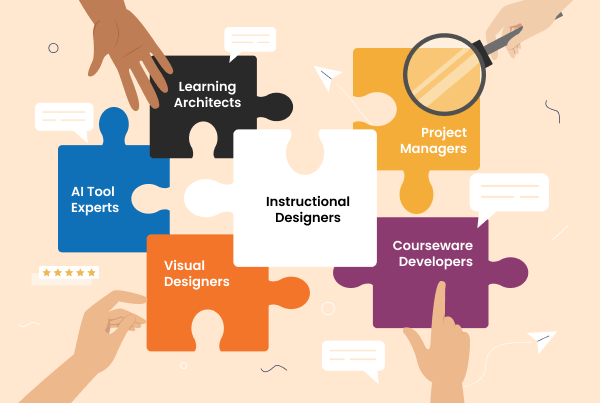When L&D Staff Augmentation Wins Over Outsourcing
In the world of corporate Learning and Development (L&D), one thing is certain: demands on your internal team are growing faster than your headcount. New tools, tighter deadlines, evolving business priorities, and shrinking budgets are forcing L&D leaders to make tough calls. One of the biggest? Whether to outsource learning projects or bring in additional support.
On the surface, outsourcing might seem like the obvious solution: hand over the work and let a third party handle everything from end to end. But eLearning outsourcing isn't always the most effective path, especially if your team has the skills, systems, and vision in place. Often, what you really need is staff augmentation.

Image by CommLab India
Staff augmentation allows you to retain control while scaling up your team's capabilities with external experts. Whether it's Instructional Designers (IDs), visual designers, LMS administrators, or courseware developers, this model lets you fill specific gaps without sacrificing ownership, quality, or agility.
5 Signs You Need L&D Team Augmentation, Not Full Outsourcing
1. You Need Control Over Quality And Processes
L&D isn't just about delivering content. It's about aligning with internal processes and meeting specific performance goals. When you outsource a project end-to-end, you often relinquish control over how things are done. You may get quality work, but it might not align with your instructional strategy or even your learner expectations.
That's especially true when vendors use pre-built templates or standard approaches that don't reflect your organization's culture. In contrast, staff augmentation embeds experienced professionals into your existing processes. They use your tools, follow your review cycles, and build solutions that feel native to your learning ecosystem.
If your team is committed to maintaining brand consistency and learning experience quality—and wants real-time collaboration, not periodic check-ins—then staff augmentation is the right model. It provides the oversight you need while ensuring instructional alignment and creative consistency. This is especially important in industries such as healthcare, finance, or compliance-heavy sectors, where nuances in tone and precision in information can have real-world consequences.
Furthermore, having augmented team members working directly under your supervision helps build accountability and faster feedback loops. Rather than going through long chains of communication, your team can make instant course corrections, reducing rework and accelerating time-to-launch.
2. Sometimes You Need Extra Expertise, Not Just Extra Hands
Many large organizations already have capable internal learning teams: brilliant Instructional Designers, seasoned SMEs, and even media developers. But what they often lack is a combination of specialized expertise and additional capacity to manage complex, multi-track learning programs at scale.
It's not just about needing "more people." It's about needing the right mix of high-skill professionals, from senior learning consultants who understand adult learning strategy, to creative designers who can bring content to life, to experienced project managers who can juggle global timelines and stakeholders without dropping the ball.
When multiple launches are happening across regions, or when internal teams are already working at full tilt, outsourcing the whole project may feel like overkill—or worse, a loss of control. That's where staff augmentation fits perfectly. It lets you plug in the exact expertise you're missing, without disrupting your existing workflows or compromising on quality.

Image by CommLab India
This approach is especially useful during global rollouts, systems training, or when building high-stakes compliance or leadership programs. You can bring in a learning strategist to refine your curriculum, a graphic designer to build engaging visuals, or a project manager to coordinate with business units, all while keeping your core team in the driver's seat.
And because these professionals are embedded in your systems and tools (like JIRA, Trello, or Asana), they integrate quickly with your cadence. You're not onboarding junior freelancers; you're extending your team with qualified specialists who hit the ground running and raise the bar.
For mid-sized L&D teams trying to deliver enterprise-wide results, this model offers both scale and strength, helping you meet expectations without burning out your internal resources.
3. You Have A Moving Target, Not A Locked Scope
Most outsourcing agreements require well-defined scopes and timelines. But what if your project is still evolving? Maybe you're piloting a new LMS, revamping your onboarding, or developing training for a product still in development. The more fluid the project, the less suitable traditional outsourcing becomes.
Staff augmentation offers the flexibility you need. You can onboard experts quickly, make course corrections in real time, and adjust priorities without renegotiating contracts. This agility is especially valuable when you're experimenting with new formats, iterating based on feedback, or building a learning strategy as you go.
With augmented staff embedded in your team, you can adapt without friction. You won't be locked into rigid deliverables; instead, you get partners who evolve with your needs.
For example, when an organization is rolling out a major change initiative, like digital transformation or restructuring, the training content often changes weekly as leaders finalize processes and policies. Having flexible staff in place allows you to respond to this shifting landscape in real time, instead of waiting for a new SOW to be approved.
4. Cost Optimization Is A Priority, But So Is Speed
Outsourcing often comes with a hefty price tag, especially for comprehensive, high-volume projects. You're paying for project management, infrastructure, and often a premium for speed. But what if you only need a few roles filled, not the entire production team?
L&D staff augmentation lets you pay for specific talent where you need it most. Need one LMS administrator for a month? Or a visual designer for a specific course? You get precisely that. This model eliminates unnecessary overhead while allowing you to scale quickly.
Plus, because augmented staff work within your systems and processes, you cut down on onboarding time. You skip the knowledge transfer marathons and hit the ground running. For many L&D leaders, this combination of speed and cost control is a game-changer.
Additionally, staff augmentation allows you to better forecast budgets by allocating funds directly to resources instead of inflated, all-inclusive vendor contracts. You can flex your team up or down depending on project phases and avoid long-term retainers when the work doesn't justify them.

Image by CommLab India
In a time where CFOs are scrutinizing every budget line, L&D leaders who can show how they're doing more with less will always win more internal credibility.
5. You're Building Long-Term Capability, Not Just A One-Off Project
Sometimes, the goal isn't just to deliver a course or launch a program. It's to build internal muscle. You want your team to learn new tools, standardize processes, or adopt a new learning methodology. Outsourcing may get the work done, but it doesn't transfer knowledge. Your team stays dependent.
Let your team work with external experts with staff augmentation. They mentor, transfer skills, and often leave behind templates, checklists, and documentation your team can reuse. This builds capability over time.
For instance, many organizations use staff augmentation when transitioning to new platforms or restructuring. The augmented team doesn't just do the work, they upskill your team in the process. When the engagement ends, your people are better equipped for the future.
This capability-building aspect is especially valuable in global organizations, where training development needs to be localized and standardized at the same time. Augmented staff can help central teams build scalable frameworks that regional teams can adapt and deploy.
L&D Team Augmentation In Action: Real-World Examples
Across industries, from manufacturing to finance to logistics, L&D teams are using staff augmentation to meet critical needs.
In manufacturing, internal teams handling large-scale ERP training programs have added IDs and visual designers to support global rollouts without losing control of messaging and timelines.
In tech and finance, staff augmentation has helped support innovation and system implementation initiatives, allowing internal teams to maintain agility while launching complex, high-impact training.
In logistics, global L&D teams have brought in additional IDs and LMS administrators to help standardize content across regions while ensuring localization, compliance, and on-brand learning experiences.
In each of these cases, organizations chose augmentation not because they lacked internal expertise, but because they needed to extend their capacity and ensure consistency during times of high strategic importance.
Staff augmentation wasn't a workaround; it was a deliberate choice to strengthen internal ownership while improving delivery outcomes.
Why Staff Augmentation Works
- Faster ramp-up: Professionals already familiar with corporate learning environments.
- Alignment with your systems: They work inside your LMS, authoring tools, and templates.
- Cultural fit: They collaborate directly with your team—no silos, no disconnect.
- Budget flexibility: You pay only for the skillsets you need, when you need them.
- Capability-building: Your internal team learns through collaboration.
- Speed with oversight: Augmented staff can hit the ground running without compromising governance or internal priorities.
For large enterprises, this is not a stopgap. It's a smart, sustainable strategy.
Final Thoughts: Scale Smart, Stay Agile
Staff augmentation isn't a compromise. It's a competitive advantage. If your L&D team is already doing good work and just needs the right support to do more, augmentation gives you flexibility without friction. It helps you manage volume without surrendering control. It lets you keep your standards high while keeping costs in check.
You don't need to outsource your learning challenges. You need partners who can plug in, power up your team, and leave you stronger than before.
Want to see how staff augmentation can help you deliver more with less? We'd love to show you how it works in practice. Let's talk.








